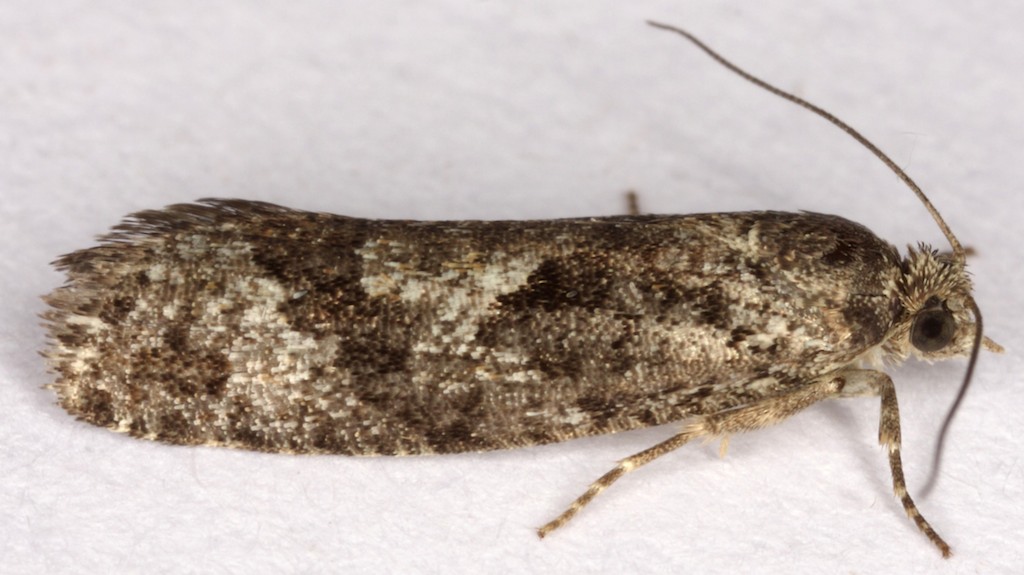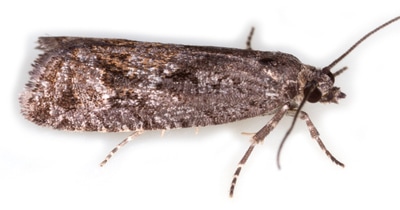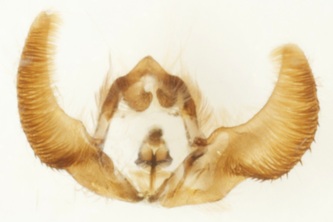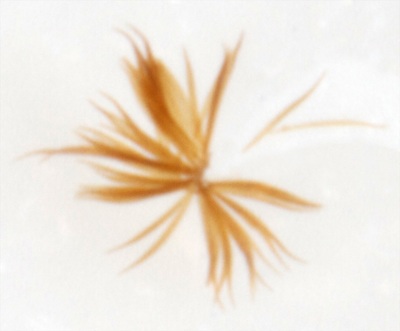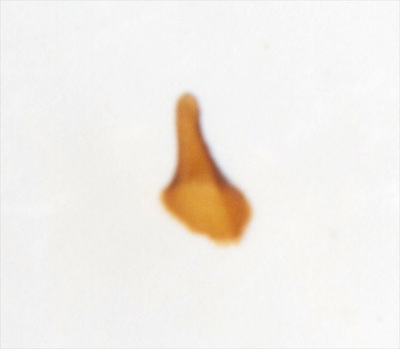49.257 Zeiraphera griseana (Larch Tortrix)
ws: 16-22mm (BTM), fw 7.5-10.5mm (Sterling & Parsons); Jul; larch (Larix decidua), pines (Pinus spp); local in woodland throughout GB
Synonym: Zeiraphera diniana (BTM, Pierce & Metcalfe)
Synonym: Zeiraphera diniana (BTM, Pierce & Metcalfe)
ID: Similar to Z. isertana (ws 14-19mm) but averages larger. Z.griseana has a characteristically farinose (like flour) coloration of the forewing, head and thorax, due to white-tipped scales. Also the pale dorsal blotch is more triangular, larger and tends to reach the costa; subquadrate and smaller in Z.isertana.
Male genitalia: Zeiraphera species have a "shouldered" tegumen with a small uncus, prominent drooping socii, the costa (dorsal margin) of the valva shows a small prominence medially and the ventral border shows an indentation at the junction of sacculus and valvula. Z.isertana has a narrow valva only slightly broader at the base than at the apex, its ventral border is shallowly concave subapically; and the medial costal prominence is more well-marked than in the other species. Z.griseana has a more angular sacculus and a deeper indentation at the junction of the sacculus with the valvula than in the other species; the ventral border of the valvula is smoothly convex and the valvula is much broader at its base than at its apex. Z.ratzburgiana has a very shallow indentation at the junction of sacculus and valvula, the ventral margin of the valvula is very convex at ~junction of proximal 1/3 with distal 2/3, the valvula is broad and narrows relatively little in apical third, and the medial costal prominence is minimal. Z.rufimitrana is not shown at dissection group; the drawings in Pierce and Metclafe suggest a relatively short broad valva. P&M also describes differences in the number of cornuti: ~50 for Z.griseana, ~13 for Z.ratzeburgiana, ~21 for Z.rufimitrana and ~15 for Z.isertana.
Summary:
Z.isertana - valva narrow, medial costal prominence strong
Z.griseana - valva broad, tapering; sacculus angular
Z.ratzburgiana - valva broad, covexity of valva more prominent than concavity of sacculus/valvula junction
Z.rufimitrana - valva broad, short
Female genitalia: Zeiraphera species have an elongate ovipositor. The number and size of the signa and the shape of a plate connecting the apophyses anteriores (sterigma) seems to provide a distinction between the Zeiraphera species. Only Z.ratzeburgiana and Z.isertana are shown at Moth Dissection. All 4 species are illustrated in Pierce & Metcalfe who also provide a limited description. Z.griseana has a single signum, Z.rufimitrana has one standard horn-like signum and one small scobinate plate, both Z.ratzeburgiana and Z.isertana have 2 horn-like signa. P&M describe the plate connecting the apophyses anteriores as "long emarginate" in Z.ratzeburgiana and Z.griseana, "long deeply emarginate" in Z.rufimitrana and "slightly emarginate" in Z.isertana. So once recognised as Zeiraphera by the elongate ovipositor and emarginate sterigma, Z.griseana is readily distinguished as it is the only Zeiraphera species with a single signum and no scobinate plate.
Male genitalia: Zeiraphera species have a "shouldered" tegumen with a small uncus, prominent drooping socii, the costa (dorsal margin) of the valva shows a small prominence medially and the ventral border shows an indentation at the junction of sacculus and valvula. Z.isertana has a narrow valva only slightly broader at the base than at the apex, its ventral border is shallowly concave subapically; and the medial costal prominence is more well-marked than in the other species. Z.griseana has a more angular sacculus and a deeper indentation at the junction of the sacculus with the valvula than in the other species; the ventral border of the valvula is smoothly convex and the valvula is much broader at its base than at its apex. Z.ratzburgiana has a very shallow indentation at the junction of sacculus and valvula, the ventral margin of the valvula is very convex at ~junction of proximal 1/3 with distal 2/3, the valvula is broad and narrows relatively little in apical third, and the medial costal prominence is minimal. Z.rufimitrana is not shown at dissection group; the drawings in Pierce and Metclafe suggest a relatively short broad valva. P&M also describes differences in the number of cornuti: ~50 for Z.griseana, ~13 for Z.ratzeburgiana, ~21 for Z.rufimitrana and ~15 for Z.isertana.
Summary:
Z.isertana - valva narrow, medial costal prominence strong
Z.griseana - valva broad, tapering; sacculus angular
Z.ratzburgiana - valva broad, covexity of valva more prominent than concavity of sacculus/valvula junction
Z.rufimitrana - valva broad, short
Female genitalia: Zeiraphera species have an elongate ovipositor. The number and size of the signa and the shape of a plate connecting the apophyses anteriores (sterigma) seems to provide a distinction between the Zeiraphera species. Only Z.ratzeburgiana and Z.isertana are shown at Moth Dissection. All 4 species are illustrated in Pierce & Metcalfe who also provide a limited description. Z.griseana has a single signum, Z.rufimitrana has one standard horn-like signum and one small scobinate plate, both Z.ratzeburgiana and Z.isertana have 2 horn-like signa. P&M describe the plate connecting the apophyses anteriores as "long emarginate" in Z.ratzeburgiana and Z.griseana, "long deeply emarginate" in Z.rufimitrana and "slightly emarginate" in Z.isertana. So once recognised as Zeiraphera by the elongate ovipositor and emarginate sterigma, Z.griseana is readily distinguished as it is the only Zeiraphera species with a single signum and no scobinate plate.
§1 Loch Rannoch, Perthsire; 29/08/2008; male; fw 9.0mm
§2 Glen Urquart, Inverness-shire; 18/07/2012; male; fw 8.0mm
§3 Glen Urquart, Inverness-shire; 18/07/2012; male; fw 8.8mm
§4 Fersit, Argyll; 03/08/2013; fw 8.9mm; female
§5 Fersit, Argyll; 03/08/2013; fw 9.1mm; male
§6 Dalmunzie (Glenshee), Perthshire; 28/08/2016; male; fw 8.8mm
§7 Bampton Grange, Cumbria; female; 09/07/2017; female; fw 8.7mm
§8 Inveruglas, Inverness-shire; 31/07/2023; male; fw 8.2mm
§9 Inveruglas, Inverness-shire; 31/07/2023; male; fw 8.5mm
All images © Chris Lewis
§2 Glen Urquart, Inverness-shire; 18/07/2012; male; fw 8.0mm
§3 Glen Urquart, Inverness-shire; 18/07/2012; male; fw 8.8mm
§4 Fersit, Argyll; 03/08/2013; fw 8.9mm; female
§5 Fersit, Argyll; 03/08/2013; fw 9.1mm; male
§6 Dalmunzie (Glenshee), Perthshire; 28/08/2016; male; fw 8.8mm
§7 Bampton Grange, Cumbria; female; 09/07/2017; female; fw 8.7mm
§8 Inveruglas, Inverness-shire; 31/07/2023; male; fw 8.2mm
§9 Inveruglas, Inverness-shire; 31/07/2023; male; fw 8.5mm
All images © Chris Lewis
Page published 12/01/2013 (§1-3) | §4&5 and female genitalia text added 28/03/2014 | §6 added 05/01/2016 | §7 added 12/04/2018 |
§8&9 added 20/12/2023
§8&9 added 20/12/2023
